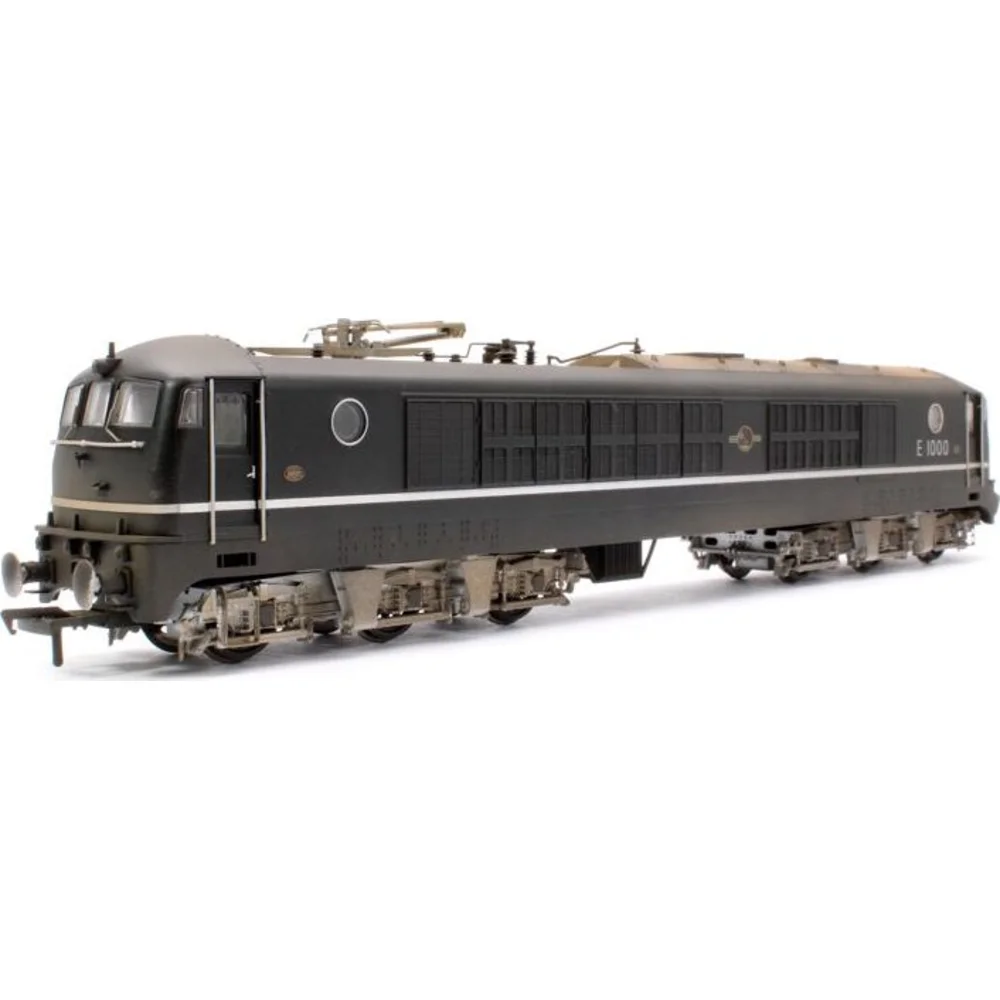Heljan 1811
British Rail Class 80 E1000 British Railways Black with Late Crest
Tooling
Heljan introduced its OO gauge model of the British Rail Class 80 in 2023, representing the unique prototype rebuilt from the gas turbine locomotive 18100 into Britain’s first 25kV AC overhead electric locomotive. Known initially as E1000 and later renumbered E2001, this experimental locomotive served as a testbed for high-voltage electrification on the West Coast Main Line during the late 1950s and early 1960s. The model fills a notable gap in ready-to-run British electric prototypes and was produced as a limited edition for Rails of Sheffield.
Tooling Features
- Construction: Highly detailed bodyshell with separately fitted wire handrails, sandpipes, and etched grilles.
- Detailing: Flush glazing, spoked wheels, sprung OLEO buffers, and accurate roof equipment.
- Couplings: NEM pockets with tension-lock couplers.
Mechanical & Electrical Specification
- Motor & Drive: Five-pole motor with twin flywheels driving all four axles (outer axles powered on each bogie).
- Lighting: Directional warm white headlights (two at the front), red tail light at rear with switchable function, cab lights, and separate engine room illumination.
- Weighting: Die-cast chassis for improved traction.
DCC Capability
The model is DCC Ready with a 21-pin socket for easy decoder installation. Provision is made for sound upgrades, with aftermarket sound projects available from specialist suppliers.
Liveries Produced
- BR Black with Late Crest and silver trim (circa 1960 condition) – E1000 and E2001 variants.
These were released as limited editions through Rails of Sheffield.
Reviews & Commentary
Early reviews and social media feedback praised the model’s fine detailing, accurate representation of this rare prototype, and smooth running qualities. The inclusion of multiple lighting functions and robust mechanism were highlighted as strong points. Some enthusiasts noted its appeal as a unique addition for collectors of experimental British locomotives.
Media Coverage
The Class 80 tooling featured prominently in model railway press and online platforms following its announcement. Video reviews and unboxings from retailers such as Rails of Sheffield showcased the model’s specification and historical significance. Discussions on RMweb and other forums generally commended Heljan for tackling such an unusual subject.
Interesting Notes
The prototype Class 80 was originally built as gas turbine locomotive 18100 by Metropolitan-Vickers in 1952 before conversion to AC electric form. Its role in pioneering 25kV electrification makes it a historically significant subject, and Heljan’s tooling reflects this with accurate body variations and authentic detailing.
Class & Prototype
- Class: British Rail Class 80
- Traction: Electric
- Built: 1958-1958
- Total Built: 1
No prototype found.
Operator & Livery
- Operator: British Railways
- Livery: Black with Late Crest
British Railways transformed Britain's fragmented rail network into a unified national system following nationalisation on 1st January 1948. Created from the "Big Four" companies under the Transport Act 1947, BR operated most of Great Britain's railways until rebranding as British Rail in 1965, managing over 20,000 route miles and inheriting nearly 20,000 locomotives of diverse designs.
The organisation pioneered standardisation through its revolutionary BR Standard locomotive programme (1951-1960), producing 999 advanced steam engines under Robert Riddles' direction. These included the versatile Britannia Pacifics, mighty 9F freight engines, and mixed-traffic classes that incorporated the best features from all predecessor companies. The 1955 Modernisation Plan accelerated diesel and electric traction development, creating fascinating mixed-traction operations.
Notable achievements included establishing unified locomotive classification systems, introducing distinctive corporate liveries, and managing the complex transition from steam to modern traction. BR's six regional structure preserved operational diversity whilst enabling standardisation of practices, signalling, and rolling stock that had eluded private enterprise for over a century.
The BR era represents steam traction's final flowering alongside emerging diesel technology, creating unparalleled locomotive variety. Today, this heritage remains highly popular with railway enthusiasts through extensive preserved fleets, heritage railway operations, and comprehensive model ranges from manufacturers like Hornby, Bachmann, and Dapol, making BR subjects essential for authentic post-war British railway modelling across all scales.
British Railways' plain black livery remained the standard finish for freight and shunting locomotives from 1956 onwards, representing the most economical and practical scheme for inherently dirty industrial operations. Plain black locomotives retained red buffer beams and received white lettering in Gill Sans style, maintaining the utilitarian approach established in the early BR period. The livery was applied to a vast range of locomotive types, from powerful freight engines like the 9F class down to humble shunting locomotives and industrial engines working in goods yards, collieries, and freight terminals.
From 1956, these locomotives received the new "Lion and Crown" emblem (nicknamed the "Ferret and Dartboard"), a proper heraldic device featuring a rampant lion emerging from a crown and holding a spoked wheel, enclosed in a roundel with "British Railways" displayed on bars either side. Unlike earlier practice, the new emblem was positioned centrally on tender sides or tank sides without reference to axle boxes, following heraldic conventions with the lion facing left. This livery period coincided with increasing neglect as steam operations wound down, with locomotives often covered in layers of grime that obscured the paintwork and made the already austere black finish appear even more weathered. The plain black finish continued until individual locomotives were withdrawn from service, with many examples lasting into the final years of steam operation in 1968. For modellers, this livery represents the twilight of steam freight operations, capturing the workaday reality of British Railways' industrial locomotive fleet during the final phase of steam traction.
